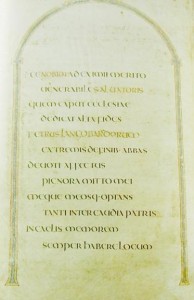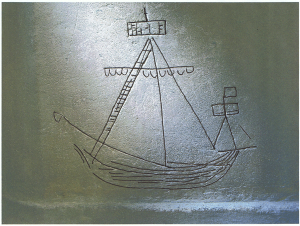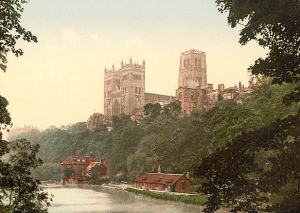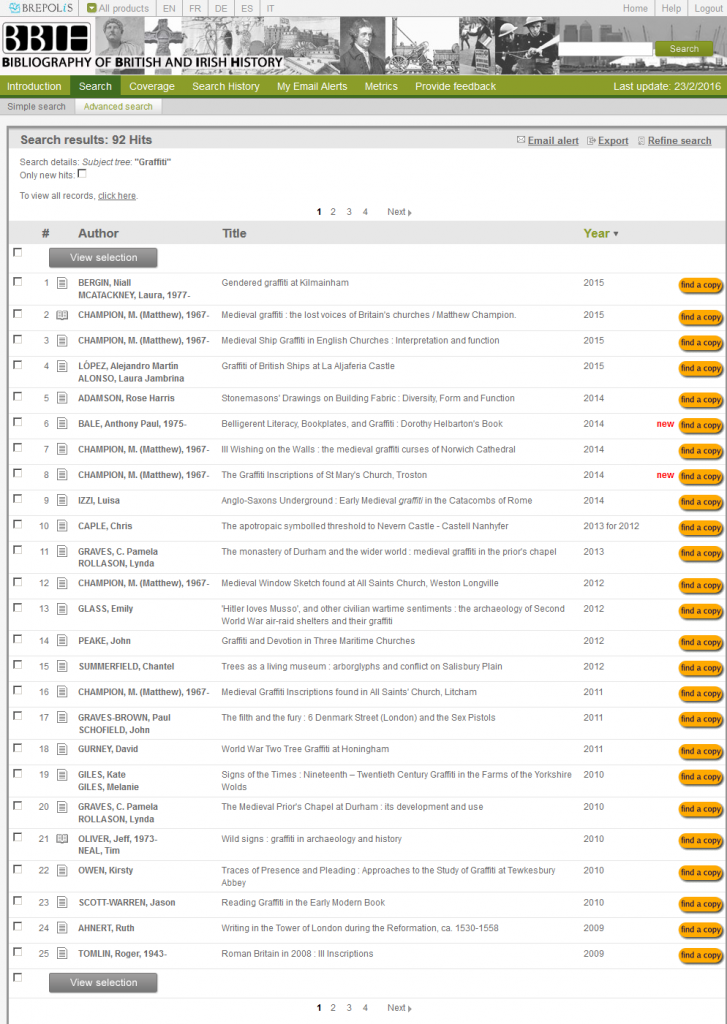The theme of graffiti seems to be a popular topic of late, and a search on the Bibliography reveals the interesting array of material that has been published recently. The term ‘graffiti’ often has negative connotations in our modern society as an act of vandalism, but the OED definition of a graffito is ‘a drawing or writing scratched on a wall or other surface’, and, as the following resources show, represent a number of different purposes.
A book chapter in England and Rome in the Early Middle Ages titled Anglo-Saxons Underground: Early Medieval Graffiti in the Catacombs of Rome explores the Anglo-Saxon trend of pilgrimage to the sacred burial tombs of the early Christian martyrs. As the catacombs of Rome were manipulated architecturally and visually to accommodate ever-increasing numbers of worshippers, pilgrims added their own marks by way of graffiti; creating an eternal link between themselves and the saint, long after they had returned to their homeland. From the four hundred or so medieval inscriptions identified, twenty-six Anglo-Saxon names have so far been recorded, including one female name. The names have been written in an uncial script with insular letter forms (four in runic letters), suggesting they were etched between the 7th-9th century. In the catacombs of Commodilla, twelve Anglo-Saxon inscriptions have been found grouped together on the fresco of St Luke, suggesting a band of English pilgrims travelling en masse. In the tombs of SS Marcellinus and Peter, the female name Fagihild was found written in runic letters among ten Anglo-Saxon names. From sources such as the The English Correspondence of Saint Boniface, it is clear that women often made pilgrimages to Rome, yet it is still satisfying to find physical evidence of Anglo-Saxon women travelling alongside their male peers. Further analysis is required to discern whether the name was inscribed by the woman herself or by a companion, raising further questions of literacy amongst women in this period
However, not all acts of inscription had a spiritual purpose. The book chapter Amiatinus in Italy : The Afterlife of an Anglo-Saxon Book in Anglo-Saxon England and the Continent charts the story of the Codex Amiatinus, a vulgate bible created in Wearmouth-Jarrow under the abbacy of Ceolfrith in the eighth century. Intended as a gift for Pope Gregory II, the codex disappeared shortly after Ceolfrith’s death en route. The huge manuscript, measuring almost twenty inches high, re-emerged in the ninth century in an abbey in Tuscany. Close scrutiny of the dedication page in the Amiatinus has revealed that the original name ‘Ceolfrith of the English’ was deliberately erased, and replaced with ‘Peter of the Lombards’, concealing its Anglo-Saxon origins for centuries (pictured left, click to enlarge).
Medieval graffiti in churches has inspired much academic interest of late, with the Norfolk Medieval Graffiti Survey documenting a growing corpus of inscriptions that have formed the basis of several articles. Matthew Champion has produced an abundance of material, such as Medieval Graffiti : the Lost Voices of Britain’s Churches, The Graffiti Inscriptions of St Mary’s Church, Troston and Medieval Ship Graffiti in English Churches : Interpretation and Function. The ship motif features significantly in medieval churches and is explored further in Graffiti and Devotion in Three Maritime Churches. While it is clear that these etchings have an apotropaic function, serving as a symbol to avert evil, these marks are open to multiple interpretations. Are they requesting protection for or giving thanks for a safe voyage? Could they be associated with a maritime guild? Churches are intrinsically linked to the nautical world, with the word ‘nave’ coming from the Latin word ‘navis’ meaning ship, which may go some way to explain why so many ship images appear in churches so far inland. To modern tastes, the act of carving a personal image (particularly in a church) may seem like an act of vandalism, but to medieval thinking it was an act of piety; a way of interacting with very fabric of the church. This is demonstrated in primary sources such as The Life of Christina of Markyate, where Christina is recorded as scratching the sign of the cross on a monastery door with her fingernails to mark her devotion to the church.
While most graffiti in churches serves as an act of piety, there is a dark side. The article Ill Wishing on the Walls: the Medieval Graffiti Curses of Norwich Cathedral highlights three inscriptions found in different locations in the cathedral, written in pre-reformation script with inverted lettering. Of the three inscriptions, one is particularly well preserved, clearly spelling the name ‘Keynfford’ upside down and back-to-front, with an astrological symbol underneath (See NMGS image 37). Whilst examples of book curses from this period have been well documented, curses in churches may prove an interesting new area of research.
Stonemasons’ Drawings on Building Fabric : Diversity, Form and Function provides a practical insight into how stonemasons used their working space as a template for grand building designs, and carries a reminder that many creators of graffiti were not necessarily literate. This theme is also explored in The Apotropaic Symbolled Threshold to Nevern Castle – Castell Nanhyfer, an article that probes deeper into the significance of incorporating talismans into new buildings. The Monastery of Durham and the Wider World : Medieval Graffiti in the Prior’s Chapel is an interesting analysis of graffiti revealed behind plastered wall-paintings in the prior’s lodging, which at times was used as an administration base. Therefore the graffiti seems to hold little apotropaic value, but seem to represent a fascinating snapshot of the various members of religious and lay community who used this space, and carved out their marks, perhaps in moments of idleness.

Marginalia in London, British Library, Add MS 35157, fol. 31r
Book Destruction from the Medieval to the Contemporary contains an extremely entertaining chapter titled Belligerent Literacy, Bookplates, and Graffiti: Dorothy Helbarton’s Book, concerning a 16th-century text of the Brut Chronicle, with the interesting addition of more than 60 marginal inscriptions bearing the name Dorothy Helbarton. While marginalia or glosses were considered helpful additions to the understanding of texts, as in the C version of Piers Plowman pictured on the right, in this instance the scrawling of Dorothy (or rather her scribe), seems to be an aggressive act of declaring ownership, with little interest in the textual material.
Moving on from early modern times, Graffiti of British Ships at La Aljaferia Castle details the intricate inscriptions left behind by prisoners of the Napoleonic Wars on the walls were they were held captive, and Gendered Graffiti at Kilmainham discusses the graffiti left by the women prisoners during the Irish Civil War. Words and phrases of nationalist sentiments were feminised by the women to represent their involvement, and perhaps as a way of avoiding being airbrushed out of the historical narrative. Finally, ‘Hitler Loves Musso’, and Other Civilian Wartime Sentiments : the Archaeology of Second World War Air-Raid Shelters and their Graffiti in Beyond the Dead Horizon: Studies in Modern Conflict Archaeology gives an insight into how air-raid shelters served as communal places to while away the time during the bombings; amongst the anti-Hitler daubings, there are drawings of Disney characters, mathematical sums for children and games of noughts and crosses.
Through all of these resources, what is notable is that while graffiti marks serve a wide and varied purpose, they also represent the often unrecorded story of the ordinary people, who may have been illiterate or poor, but have nevertheless made their voice heard through the scratchings on a surface. For a comprehensive list of all resources available, please visit the Bibliography of British and Irish History.






